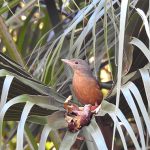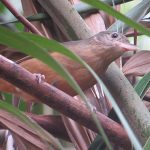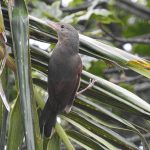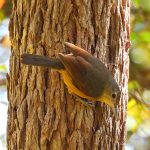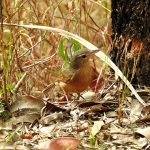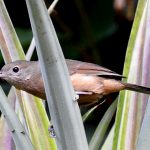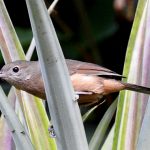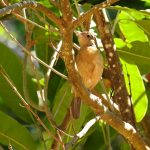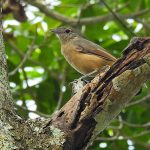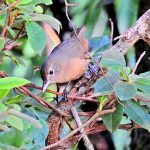LITTLE SHRIKE-THRUSH
The Arafura Shrikethrush: The Melodist of Australia’s Northern Forests
Hidden within the lush, green embrace of Australia’s northern rainforests, a small bird weaves a tapestry of sound that stirs the senses and awakens a sense of wonder. The Arafura Shrikethrush, also known as the Little shrike-thrush, may not dazzle with bright colours, but its melodic voice paints a vivid picture of life in the wild.
Visual and Multi-Sensory Portrait
Imagine standing at the edge of a sun-dappled rainforest at dawn. The air is thick with humidity, scented with the earthy perfume of wet leaves and rich soil. Among the interlacing vines and towering trees, a bird calls—a sequence of whistles, chortles, and trills that echo through the green corridors. The bird itself is subtle in appearance, cloaked in gentle shades of brown and grey, perfectly camouflaged against the shifting shadows.
- Sight: Plumage of muted browns and greys, blending with the bark and foliage.
- Sound: A rich, complex song—sometimes a gentle whistle, other times a lively trill—rising above the forest’s ambient chorus.
- Touch: If you could reach out, you’d find its feathers soft yet sleek, built for swift and agile movement.
- Smell: The ever-present aroma of damp earth and decaying leaves, the very environment that sustains it.
Habitat and Range
| Region | Habitat Type |
|---|---|
| East Coast of Australia | Subtropical rainforest |
| North-eastern NSW & SE QLD | Dense, humid subtropical forest |
| Northern NT & Kimberley, WA | Tropical rainforest, thick scrub |
The Arafura Shrikethrush thrives where the forest is dense and life abounds. It moves quietly through the leafy understorey, rarely straying far from the protective canopy overhead.
Diet and Behaviour
An expert forager, the Arafura Shrikethrush is always alert, its keen eyes scanning for movement.
- Food Sources: Insects, spiders, small fruits
- Foraging Technique: Searches through leaf litter, pecks at bark, snatches prey from low branches or even mid-air
- Movement: Agile, quick, and unobtrusive—master of its environment
Its diet is as varied as the forest itself, allowing it to adapt to seasonal changes and shifts in food availability.
The Enigma of the Songbird
Despite its enchanting voice, the Arafura Shrikethrush remains elusive, often unseen by those who walk the forest paths. Its life unfolds largely undisturbed, a testament to the resilience and quiet beauty of Australia’s native birds.
Conservation and the Delicate Balance
Yet, even in these remote sanctuaries, challenges abound. Deforestation and habitat loss pose significant threats. As trees fall and forests recede, the intricate web that sustains these birds begins to unravel. The fate of the Arafura Shrikethrush is tied to the fate of its forest home.
Conservation Insight:
Protecting these habitats is not only about saving one species—it’s about preserving the rich, interconnected biodiversity that defines Australia’s wild places.
The Arafura Shrikethrush is more than a bird; it is a living symbol of the wild spirit that thrives in Australia’s northern forests. Its song reminds us of nature’s subtle wonders and the profound responsibility we share in safeguarding them.
Let us listen carefully—not only to its tune, but to the message it carries:
To cherish and protect the natural world is to honour the legacy of life itself, ensuring its beauty endures for generations yet to come.
To experience the Arafura Shrikethrush is to glimpse the heart of Australia’s rainforests—an encounter both humble and profound, echoing the call to preserve the wild for all who follow.
Photo Gallery
Sharon: The Little Shrike Thrush has had a name change in Northern areas of Queensland, to the Rufous Shrike Thrush. He’s a little different to his southern Relo’s but still very similar. This is a bit of a combo of the Shrike Thrushes that I have had ‘Close Encounters’ with.

